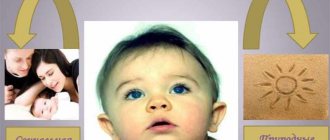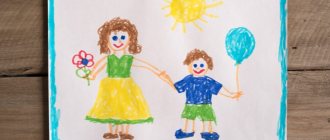We are all adults – we were once little children. And when we grow up, this child that we were in our past continues to live inside us.
And if our childhood was quite painful and difficult, then our inner child needs healing. Even though we have grown up, our wounded inner child continues to make itself felt. And ask us for help.
This article is about the inner child. And in it we will talk about who the inner child is. What types of inner child are within us. Why work with the inner child is needed, and how to do it. And how to love yourself through healing your inner child.
What is important to know about the inner child?
The inner child is a “part” of our personality. Which stores all our memories, feelings, needs, reactions, attitudes towards ourselves and others, patterns of behavior that we have preserved from our childhood.
When we react to some situations in the same way as we did in childhood. Then we react from our inner child.
If in childhood some of our important psychological needs were not satisfied, then our inner child “gets stuck” and cannot further grow and develop.
How to love him
Some parents make their son or daughter feel unworthy. With their criticism and reproaches, they inspire the offspring that he is bad, unworthy of love. Children grow up with this attitude. All children from destructive families do not know how to love themselves, they blame and hate themselves for being bad. Without self-acceptance and love there can be no healing. How to love your inner child?
Loving yourself means hearing and satisfying your needs and desires, taking care of yourself, appreciating and respecting yourself. How often do you take time for yourself, how often do you thank yourself and compliment yourself? Or do you more often sacrifice yourself for the sake of others and scold yourself for every little thing? What strengths do you have? Or are you sure that you consist only of shortcomings?
Right now, make a list of your strengths, organize an honest conversation with yourself. And at the same time, make a list of your true desires. Give yourself compliments every day, thank yourself and cross out one wish at a time (the deadline depends on the scale of the task - it can take a day or a month). Apply this attitude to everything, whether it's choosing what to eat for breakfast or choosing where to work. To love your inner child, you need to understand yourself. Communication will help with this.
Important! Every child wants to know that they are loved. Every person, regardless of the state of his inner child, needs to hear kind words, feel support and care from other people, and receive attention. But it’s even more important to give all this to yourself.
Types of inner child
Our inner child can be different. We can say that there are different parts of children in us, in our psyche. For example, we have:
- An adaptive child is a child who adapts to his parents, obeys their rules, and tries to meet their expectations. Also, an adaptive child can manifest itself in us as a rebellious child, when we, on the contrary, try to rebel against these rules, do the opposite.
- And a free child is a child who behaves the way he wants. Regardless of parental rules and expectations. He does not try to obey or rebel against his parents' demands. And you behave freely and naturally.
We can also have children of different ages inside us:
- An unborn child - which retains the memory of our intrauterine development.
- Inner baby.
- Young child (1-3 years).
- The child is a preschooler (4-6 years old).
- Child 7-10 years old.
- Inner teenager.
There may also be inner children within us:
- A happy child is a child whose needs are met. Which is allowed to manifest itself and develop naturally. Who is loved and supported.
- A traumatized, wounded inner child is a child who was born and formed as a result of the fact that our needs for love, acceptance or security were not met.
- A playful child is a child who loves to have fun, play, and act naturally and spontaneously. He loves to learn new things and is delighted with different adventures.
- Magical – very creative. Likes to fantasize and come up with something new and interesting. He is a dreamer.
- A feeling child is a child who experiences feelings and knows how to empathize with others. It is responsible for our capacity for affection and love.
- Angry - vindictive and vindictive. Tends to punish other people and get angry with them. He is responsible for our ability to defend ourselves.
- A forgotten inner child is a child with whom contact has been lost, who has been forgotten. A forgotten inner child can lead us as adults to crises, depression, and a feeling of meaninglessness and uselessness of our own lives.
Causes of irritation
"Hurry up"
Modern man, it would seem, has everything: computers, phones, cars, microwaves and other things designed to simplify life. Desperately lacking only the most important thing - time. The accelerated pace of life carries us forward. And if something or someone tries to slow us down even a little, it’s terribly annoying. And this is understandable. Judge for yourself.
In the morning, you need to quickly push your child into kindergarten and get to work. In the evening, the child wants to show the drawing, cuddle, sit on his knees, and take a walk. No - mugs! After the club, quickly go home. You also have to prepare dinner, take care of small household chores, help your eldest prepare homework and, at least a little, rest. Then go to sleep quickly so that you can start over tomorrow. It’s not surprising that the child’s hundred thousandth request, “I want to slide down the slide for the last time,” can cause a mother to explode.
"Emotional swing"
Our generation was not treated very well when we were children. It was somehow not customary to take care of children's feelings. We dealt with our emotions ourselves as best we could. Many felt the lack of love. And so we grew up and had our own children. “Everything will be different in our family,” we decided and began to fully consider the feelings of our children.
And everything would be fine, but it’s not so simple. Sometimes children sit on their necks and dangle their legs cheerfully, feeling permissiveness; sometimes parents lash out at the model of parent-child relationships learned in childhood. The reasons may be different, but the result is the same - sooner or later parents lose their temper. Then comes the feeling of guilt. This is where the swing begins.
As a result, we allow everything to our children and try to deal with their emotions and reactions, then suddenly it bursts out “how long can you run around with him!” Then the race about “I couldn’t restrain myself again.” The parent is trying to make amends. The feeling of guilt is oppressive and haunts, which again leads to irritation. This completes the circle: irritation - guilt - irritation. And the further you go, the more difficult it becomes to get out of it.
"What will they think of me"
“In the group with my son, the girl already reads fluently, but she still can’t learn my alphabet.” So the mother laments and loses sight of the fact that her son is only five, and in general it’s normal that he doesn’t know how to read yet. Now it is more important for him to develop a love of reading. Mom overlooks the fact that this girl may not like books precisely because of the constant pressure to read from an early age. Unless, of course, she's a prodigy, which doesn't happen very often. But the parent, comparing his child not in his favor, begins to look at him critically, find fault and constantly pull him back. This kills the joy of communication and inevitably leads to chronic irritation.
The Wounded Inner Child and Relationship Trauma
The traumatized, wounded inner child is a part of us that carries the imprint of our psychological traumas.
Trauma is our psychological wound. This is our reaction to some event or to many similar events that our psyche could not cope with. And as a result, it was divided into a traumatized part (i.e., our wounded inner child) and a part of the protector, the persecutor.
Such a traumatic event could be:
- something extreme. For example, an attack, a fire, a war, someone’s murder, a natural disaster, etc. Then we develop a shock trauma.
- as well as many unpleasant, “softer” events, but recurring regularly. For example, psychological violence, violation of agreements on the part of the parent, lack of attention, rejection, non-acceptance of certain qualities, etc. As a result of such events, we develop developmental trauma or, in other words, relationship trauma.
Our traumatized inner child encourages us to experience again and again similar painful events that caused us to be traumatized. To finally do something differently about this event and heal. And another part of us, our inner defender, seeks to avoid such an event. Protect us from recurrence of trauma.
This inner protector, which protects us from repeating relationship trauma, can manifest itself through fear of intimacy. When we are afraid to let another person close to us or are afraid to enter into a relationship at all. Our fear of close relationships is formed precisely as a result of relationship trauma.
The healing of the inner child occurs through the healing of its “wounded part.” That is, through working with relationship trauma. And as a result of his healing, our ability to have close, trusting, loving relationships with other people increases.
Essence and features
The main characteristic of the psychological crisis of the 7th year of life is the rapid acquisition of new features that are characteristic of adults. The baby’s psyche loses its naivety and openness, and the inner world becomes more complex. He learns to analyze the actions of others and their reasons, begins to think about his words, and can hide the real motives of his own actions.
The transition from preschool to school age requires a child to take completely new actions: finding his place among classmates, adapting to an unusual social circle. A new schoolchild compares his successes with the achievements of other children, comes to terms with the loss of leadership positions, finds his strengths and weaknesses, and for the first time encounters criticism, competition and even ridicule. This is a blow to children's self-esteem, which not every child can withstand.
The child has to grow up quickly, since in many new situations he can only rely on himself. To do this, you need to quickly develop independence and learn to make decisions. To cope with new tasks, the body rapidly gains strength, endurance, and coordination.
Due to the specifics of upbringing, boys and girls experience the crisis period differently :
- The 7-year-old crisis in boys manifests itself in restlessness, lack of concentration, and an excessive sense of competition. They need to get out their energy, so classes and homework seem like an insurmountable obstacle for them. You need a clear daily routine, discipline, and sports that will help train endurance and expend energy.
- The crisis of 7 years in girls is expressed in aggression, which manifests itself in the home environment. Girls are often excellent students and the pride of the class, but when alone with their parents they show accumulated irritability, which results in hysterics. The reason lies in the burden of responsibilities that are difficult for the child to cope with. Parents need to show maximum attention to the girl’s life, have a heart-to-heart talk, discuss her feelings and emotions.
How does the inner child manifest itself in a relationship?
Often our inner child in relationships manifests itself through some very strong emotional reactions. For example, when we become very scared. Or very sad and painful.
It can also manifest itself in us through the patterns of behavior that we used in childhood in relationships with our parents.
For example, a woman makes serious mistakes at work over and over again. Because of which her boss constantly scolds her. As a little girl, this woman behaved the same way with her mother. Who only paid attention to her when she did something wrong. And in order to receive at least negative attention from her mother, the girl deliberately made mistakes.
And having already matured, this woman unknowingly continues to receive attention from her boss (who even looks like her mother). Because she scolds her for her mistakes.
All that shortage of what we were “lacked” in childhood. We retain all this emotional “hunger” in ourselves into adulthood. And we unconsciously look for people with whom we can “play out this drama”, repeat this painful scenario. A scenario where we need something from another person, but he cannot or does not want to give it to us. Or he gives, but you have to “pay for it” very dearly.
Definition of the concept
What is an inner child in psychology, what does it mean? The inner child is a collective image that includes children’s psychological beliefs and a person’s ideas about the world and himself.
Parents help their child understand the following:
- what he is like and what awaits him;
- how it is accepted and how it is not accepted;
- what he is capable of and what he is incapable of.
Some people are luckier: parents give enough love and take a reasonable position in matters of upbringing. But some are less fortunate: parents instill in the child the idea of his worthlessness, insolvency, “badness,” and uselessness. The former develop the attitude “I am good, and the world is safe”; the latter, “I am bad, the world is dangerous.” The first ones know how to trust people, value and love themselves. The latter do not accept themselves and do not trust other people.
A child lives inside every person. He is responsible for our “wants”, openness and spontaneity, sincerity, emotionality. Remember how children behave. They are free from social masks. Children know how to be happy just like that, and express their thoughts directly. They put their desires at the head of the table. They are free to express themselves.
Gradually, under the influence of upbringing, the child gets used to following social norms, limiting his desires, and suppressing emotions. Being an adult is boring. For all the moments of joy and fun, you can thank the child within you. However, sometimes, due to trauma and a difficult childhood, a person grows up depressed and sad. He does not know how to rejoice, express his emotions, love, or be open.
What traumatizes a child?
Imagine the stress a child experiences at the moment of birth, the horror that engulfs him. For nine months he lived in ideal conditions, complete safety and comfort. And suddenly he finds himself in some new world, where hundreds of irritants fall upon him. All he needs is to regain a sense of security again. The mother’s task is to help the baby feel safe, to form the attitude “Mom is fine, everything is fine with me, everything is fine in the world.” Problems with safety (physical, mental, emotional) lead to traumatization.
For example, the following (parental mistakes) are traumatic:
- coldness and distance from parents and other significant adults;
- systematic violation of personal boundaries (physical and emotional violence);
- systematic punishment and suppression, prohibition on the expression of opinions and emotions;
- irrational criticism and insults, especially in public;
- transferring responsibility to the child, taking out your pain on him (“Because of you, I did not become a successful doctor,” “Because of you, my husband left me,” “Shame on you, you shame me all the time”).
Thus, physical, psychological and emotional injuries lead to traumatization. Over the years, some of the shocks go to the subconscious level and are, as it were, forgotten, but still continue to influence a person. The inner child remains traumatized. Moreover, an adult can be sure that there was nothing bad in his childhood. However, some signs may suggest traumatization.
Why do you need to work with your inner child?
First, working with your inner child is important to make it easier to build loving relationships.
People who have a severely traumatized inner child most often use one of two strategies for dealing with it:
- They can “hide” their inner child from themselves, i.e. “suppress” it within yourself, not allowing it to show up or manifest itself. Or “hide” only from other people, not allowing others to see themselves as such - vulnerable, needy, sensitive and loving. If we do not allow our inner child to express itself in relationships with other people, then it is difficult for us to become attached and close to another person. We become unavailable to other people, emotionally closed.
- Or people may, on the contrary, unconsciously shift all the care of their “inner child” to other people in the relationship. At the same time, without even checking how safe and reliable the other person is to come so close to them. With such a strategy, firstly, there is a very high risk of “getting hurt”, being seriously injured in a relationship. Become attached to a person with whom it is unsafe to be in a relationship. And secondly, it can be difficult for other people to take care of us all the time. Moreover, without receiving anything in return. After all, adult relationships are based on equal exchange. And when there is no balance between “taking” and “giving,” then the relationship between two adults turns into a “parent-child” scenario, becoming unhealthy. Either the person gets tired of taking care of us all the time and moves away or breaks up with us.
Both of these strategies interfere with creating a happy relationship. And to replace these strategies, you need to work with your inner child, heal it and learn to give it love, security, care and attention.
Good contact with the inner child helps us to rely on ourselves, to be more self-sufficient, and not to become heavily dependent on other people. Helps you recognize your desires and act in accordance with them.
It also helps us to be creative. Difficulties with creativity in a person arise precisely because a person suppresses his inner child and does not allow him to manifest himself.
What is the essence of the disorder?
Neurasthenia in children is a reaction to external irritating factors, the environment, or any events. It can progress in three directions:
- hypersthenic – increased activity, noisy behavior, emotional arousal. The child loses self-control and shows dissatisfaction for any reason. Constantly changes types of activities, but cannot concentrate on any one activity. Bad mood and irritability predominate;
- hyposthenic – weakness, tearfulness, fearful state. Accompanied by increased fatigue. There is lethargy in movements, a decrease in interest in things that previously caused a surge of emotions;
- transitional - neurasthenia, in which the symptoms and signs of the first two types in children and adolescents appear alternately. There are serious sleep disorders and exhaustion of the nervous system.
In general, this is a psychogenic disorder, the basis of which is a contradiction between the individual and parties significant to him (most likely, close relatives), which is resolved unproductively, unsuccessfully and irrationally. It causes painful, painful experiences. Develops in childhood, during the period of personality formation.
Neurasthenia is a functional, reversible mental disorder in which organic brain damage does not occur.
Painful overstrain of psychophysiological potentials takes the child out of the usual rhythm of life. Unable to meet the high demands of others, he considers himself incapable of overcoming difficulties in advance. There are many reasons for creating such a state, but most often it is relationships with parents.
It is the closest people who unknowingly destroy the child’s inner world. They cannot accept their child for who he is and are strict and demanding. Their children try to meet expectations, but often the demands are too high and do not correspond to their capabilities. Against this background, a disorder develops - neurasthenia.
In children, its symptoms are pronounced, but can be corrected more quickly. For adults, everything is much more complicated. At a conscious age, neurosis of this type can cause much more problems than in childhood.
Without appropriate medical care, adolescents and children develop problems with social adaptation, difficulties in building relationships with peers, and even the development of depression. If the disease is noticed in time and appropriate measures are taken, then the acquired disorders of the nervous system are completely reversible.
Loving yourself means loving your inner child.
If you feel that you don't love yourself or don't love yourself enough, then you need to work with your attitude towards your inner child.
Most likely, you don’t love yourself because you have adopted someone else’s negative attitude towards yourself. Someone significant to you as a child treated you in a way that made you feel like they didn't love you. And in childhood, we put the external inside ourselves, absorbing it like a sponge. And you also absorbed someone’s unloving attitude towards yourself, and learned to treat yourself in the same way.
And now, as an adult, you continue to treat yourself the same way, i.e. to your inner child.
Symptoms of crisis in a 7 year old child
During this period, even the most calm and obedient baby can turn into a real domestic tyrant, capricious and irritable. Features of the manifestation of the 7-year-old crisis most often consist in the fact that the child:
- does not fulfill requests, does not listen;
- capricious, stubborn;
- expresses protest, dissatisfaction, clowns around and is rude;
- does not accept criticism, gives extremely negative reactions to comments;
- tries to appear more mature, strives to communicate with older children, avoids younger ones;
- deliberately acts contrary to adults;
- devalues what previously seemed important to him;
- subject to mood swings.
To diagnose a 7-year-old crisis, it is necessary that the child clearly exhibits at least four to five signs. Otherwise, we are not talking about a crisis period, but about a local conflict situation.
Develop a loving inner parent
Healing of the inner child occurs through a loving attitude towards him. To learn to treat him with love, it is important to develop a loving and caring inner parent. In return for that critical, non-accepting, rejecting parent who is now inside you.
This process is not quick. You can't just do something today and wake up tomorrow with a loving inner parent. Long-term regular work is required for this. But if you really carry it out, then you won’t even notice how you will become more stable and filled with love.
Manifestations of the disease
With any type of neurosis, there is no damage to the brain centers, but only a functional disorder. The first signs become noticeable already in early childhood, but only a few parents pay attention to them and take appropriate measures.
The most important sign of increasing neurasthenia is a decrease in performance, as far as it would be appropriate to say about children. If we are talking about schoolchildren, then the teacher must make a lot of effort to attract attention, not to mention any return.
It is common for a child who is a carrier of the disorder to blame himself for all troubles. His self-esteem is low or at zero.
It has been observed that boys are more susceptible to the disease than girls.
Symptoms of neurasthenia in children:
- increased nervous exhaustion;
- absent-mindedness;
- diffidence;
- impaired concentration, attention;
- dissatisfaction, moodiness;
- fussiness;
- excited state;
- attacks of aggression;
- weakness;
- fast fatiguability;
- sleep disturbance.
When transitioning to a chronic form, apathy or depressive symptoms may be present. From the autonomic nervous system, jumps in heart rate and wandering pain in the abdomen or chest are observed. Excessive sweating often occurs. Appetite with neurasthenia is practically absent.
Since the manifestations of neurasthenia in children vary, its symptoms can be mistaken for some other mental disorder.
Working with the inner child. Exercises
First exercise To begin, do this work with your unborn inner child. To heal the traumas you suffered during the prenatal period.
- Imagine yourself as an adult, as a mother to your inner child. And that within you is your unborn inner child. It is important to imagine not your real mother, but yourself, as a mother to your inner child. Feel your warmth, love and tenderness for this child who is inside you. Stay with these feelings for a while.
- Then feel yourself as this unborn child. And feel love and tenderness for your mother with your whole body. Feel that you love your mother (not your real mother, but yourself, as your own mother), and your mother loves you. Feed yourself on these feelings.
- As you observe this communication between mother and inner child, periodically change your role. Either feel like a mother or a child. And feed off the love they feel for each other.
Repeat this exercise every day for a month. And then take the next age period - infancy. Repeat this exercise with your inner baby. And do it every day for a month. And then repeat everything with your inner child of early childhood, preschool age, elementary school age and your inner teenager.
Second exercise
In order for your inner child to feel his worth and feel worthy and good, it is important to praise him. And do it regularly.
For this you can keep a notebook. In which, every day, write down 5-15 points for which you praise your inner child today. It is important to repeat this exercise every day for at least a month. It is important to do this regularly and not miss days, so that you learn to praise yourself automatically, so that you develop such a skill.
Treatment
The primary examination is carried out by a local pediatrician. If he identifies any deviation, he gives a referral to a child psychologist or psychotherapist. If serious problems are detected, the patient is sent for further examination to a neurologist. In severe cases, hospitalization in the neurological department is required.
A neurologist together with a psychotherapist makes a diagnosis and prescribes treatment. The doctor analyzes the situation in the family, collects a complete history of the disease, and identifies predisposing indicators.
To achieve positive treatment results, an integrated approach is used. First of all, it is necessary to get rid of the traumatic factor, then reduce physical and psychological stress.
Treatment should be aimed at calming the child and, depending on the type of pathology, at slowing down or speeding up certain body functions. It is important to find out the parents’ opinion about the current situation: what they see as the cause of neurotic disorders.
It is recommended that the whole family attend psychotherapy sessions, because mistakes in the educational process cannot be corrected by working only with the child. Correction is carried out using various methods, including:
- Gestalt therapy;
- hypnosis;
- biofeedback therapy;
- group or family sessions;
- play therapy.
The reversibility of the problem largely depends on the immediate environment. Parents should remember that children have their own lives, and it has its own differences and characteristics, for example:
- not every child is destined to become an excellent student
- not everyone has an ear for music or a desire to attend art school;
- If the older child is interested in football, then the younger one is not obliged to do so.
Children cope with neurasthenia much more successfully than adults. This happens because children's perception of the world is not fully formed; they do not have strong convictions. The therapy gives positive results quite quickly. The destructive processes of the functioning of the nervous system stop and continue to develop in the right direction.
Healing the inner child
- If you have never worked with your inner child before, then first you need to get to know him. To do this, you can write him a letter. Or imagine that he is sitting in front of you. And looking into his eyes or in a letter, greet him and tell him everything you want to say.
- Find out from your inner child what he needs, what he wants. And find a way to give it to him. It is important that this is not a one-time job, but constant and regular.
- Analyze your relationships with people and determine which needs you most often cannot satisfy in your relationships. But you want it. Maybe it's the need for a stable and secure relationship. Or the need for recognition and praise. Or the need for warm touches and hugs. Or the need for freedom. Or the need for attention.
To change your relationships, make them happier and more nourishing, it is important to learn how to give this to yourself, to satisfy these needs for yourself. It is important to learn to notice and find people who are able, willing and able to give you what you need. Learn to talk to others about your needs and ask for them. Learn to satisfy these needs from other people yourself. And also learn to build such relationships with them that other people want to do something nice for you.
- Sometimes organize holidays for your inner child. When you do something for him all day long, pamper him and make him happy. For example, buy yourself balloons, treat yourself to cotton candy, sing yourself a lullaby, ride yourself on a carousel or swing. Give him a doll or a car, play with him and other children, watch your favorite cartoon. Take yourself to a water park, circus or dolphinarium, do something creative. Embrace yourself or the image of your inner child in your imagination. If as a child you dreamed of something, and on this day you can make this dream come true.
- Watch the feature film “Big Little Me” and do similar work with your inner child, as the heroine of the film did.
It is better to work with the inner child (and especially with its “wounded part”) together with a psychologist. If you want to learn to be more loving with yourself. And become more self-sufficient, happier and more stable in relationships through working with your inner child. Then contact me for personal consultations.
Why self-knowledge helps solve problems
Reflection and analysis are psychologists' favorite words, and for good reason. A reflective person has good access to his internal motives, feelings and thoughts and can find their psychological relationships with actions. Because he also takes into account his dark sides, he can consciously manage them.
So, for example, he can notice in time that the lack of sympathy for a colleague is less due to his unpleasant qualities and is rather caused by envy of his successes. Once a person admits this to himself, he will most likely come to the conclusion that it would be dishonest to harm a colleague. He has a good chance of maintaining good relationships at work and managing his envy from within.
It is through understanding this feeling that he can find a positive way out of this situation. Perhaps by focusing on your accomplishments and other reasons to be grateful. If this person did not recognize the fact that the success of another hurts his own ego, then he would unconsciously seek to belittle his more successful colleague in the eyes of others.
This small example shows that it is important not only to find a solution to your problems, but also to behave consciously in society. Self-knowledge and reflection have not only significance for the individual, but also social value.
This primarily concerns feelings such as powerlessness and loss. If left unanalyzed, they can degenerate into an exaggerated desire for power and recognition. In some situations, due to lack of self-awareness, political leaders can develop a lust for power that can destroy entire nations.
Therefore, my intention is to prove to readers that self-knowledge is not only the shortest way to free yourself from personal problems, but also a great opportunity to become a better person.
Self-knowledge is not only the shortest way to free yourself from personal problems, but also a great opportunity to become better.
Read more: Stefanie Stahl. The child in you must find a home. The key to solving (almost) all problems. M.: Bombora, 2022.
Signs of Injury - How to Identify
Many people do not even think about the fact that they live with childhood traumas, so I will give characteristics of people with a suppressed inner child.
- Such people have low self-esteem.
- These people are deprived of self-respect and do not have a sense of “self-worth.”
- They do not know how to take care of themselves.
- They feel insecure in everything (this is often expressed in their gait).
- They have numerous fears and phobias.
- They are indifferent to their health and appearance.
- Such people have formed the habit of being a victim.
- Not only do they not love themselves, but they also do not trust themselves.
- They have problems building close, trusting relationships.
- They do not know how to properly build personal boundaries (either they are audibly narrow or too wide), and they also do not know how to protect their personal space.
- Owners of numerous internal conflicts.
- There is a feeling of being lost; such people do not know who to be and what to want.
- Also, these people often transfer problems to others or, on the contrary, have the habit of saving everyone, thereby pointing out their complexes on others.
- Such people are very prone to various addictions, as well as dependent, unhealthy relationships.
People with inner child injuries often feel unhappy because they do not have good personal and social relationships. They do not have the strength and motivation to take actions that lead them to success.











